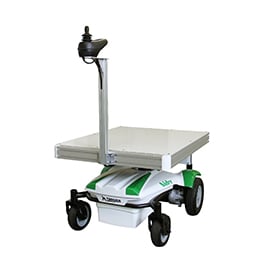Would you consider automating your factory or warehouse with AGVs?
An AGV (Automatic Guided Vehicle) is an unmanned guided vehicle or unmanned guided robot.
In recent years, with the advancement of AI and data analysis technologies, AGVs are increasingly being introduced onsite to reduce the workload of operators and solve worker shortages, both in Japan and overseas.
AGVs have been around since the 1990s, but nowadays they can be used both indoors and outdoors and are manufactured with the assumption that they will work with people by being equipped with AI.
There are various types of guidance systems, such as autonomous, magnetic, and follow-up, to meet customers' needs.
%20(1).jpg?width=1930&height=1120&name=IMG_4292%20(1)%20(1).jpg)
Self-supporting AGV
There is no need to pre-register conventional dedicated rails, guides, or walkways.
SLAM technology (Simultaneous Localization and Mapping) detects people, floor layout changes, blocked passages and various facilities in real time, and LIDAR sensors allow the vehicle to safely avoid obstacles and people.
The dedicated operation system allows for comprehensive management.
Magnetically guided AGV
This is a method in which magnetic rods are embedded in the floor surface or magnetic tape is attached to the floor surface and is read by a magnetic sensor for guidance.
It is currently the most widespread induction method in Japan and is highly reliable, although it requires construction work when installing it or changing the layout of the factory.
Tracked Robot AGV
It is positioned as a type of autonomous mobile type and moves by following a specific person or vehicle ahead of it.
Assist with indoor and outdoor hauling operations such as factories and distribution warehouses.
The laser sensor allows for day or night use, and outdoor use is also taken into consideration, with some models capable of running over 3 cm steps and even in light rain.

%20(1)%20(1).jpg)
%20(1).png)
%20(1).png)
%20(1).jpg)
%20(1).jpg)
%20(1).jpg)
